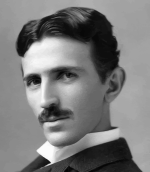Nikola Tesla was a Serbian-American inventor, electrical engineer, mechanical engineer, and futurist who lived from June 1856 to January 7, 1943. He is most known for his work on the design of the contemporary alternating current (AC) energy delivery system.
One of history's most influential inventors, Nikola Tesla is regarded for his far-sighted electrical discoveries that still have an impact on technology today. Despite his achievements, Tesla passed away without money and the recognition he would later receive more than a century later.
The "genius who lit the world" is now honored with the Tesla electrical device, a spot in the hall of fame for inventors, streets, statues, and a prominent engineer's award bearing his name, but he wasn't always that successful.
Brilliant Scientist, And Businessman
In 1856, Nikola Tesla was born in the town of Smiljan, which is now a part of Croatia but was formerly part of the Austro-Hungarian Empire. His mother worked with machines and was renowned for having a remarkable memory; his father was a priest, but she had no formal education.
Tesla's career as an inventor started early; at the age of just 26, while employed at the Central Telegraph Office in Budapest, he is said to have initially sketched out the fundamentals of a rotating magnetic field, a crucial concept that is still present in many electromechanical devices. He was eventually drawn to New York City in 1884 by Thomas Edison and his ground-breaking engineering company, Edison Machine Works, thanks to this significant accomplishment, which served as the inspiration for many of his other innovations, including the alternating current motor.
Up until a few years before his death, when he turned reclusive, the obsessive, eccentric, and frequently spectacular Tesla spoke frequently to the press about new, futuristic ideas, providing great sound bites for reporters. Tesla passed away in a New York City hotel room in 1943 while penniless and alone.
Thanks to a few supporters who publicized Tesla's work in the media in an effort to have a Nikola Tesla scientific museum established on the site of a former laboratory on Long Island, New York, Tesla's legacy has recently undergone something of a revival.
Innumerable Patents
The precise number of patents Tesla owned is contested because several may still be unidentified, according to historians. In addition to the innumerable unpatented concepts he created over his career, he is considered to have been the author of at least 300 innovations, many of which were connected to one another.
Alternating Current
Alternating current (AC), perhaps Tesla's most well-known and significant invention, was a response to his former boss Edison's allegedly inefficient use of direct current (DC) in the emerging electric age. Alternating currents may quickly change direction while operating at a far higher voltage than DC power plants, which can only send electricity flowing in a single direction in a straight line.
In fact, because of DC, Edison's power lines that crisscrossed the Atlantic seaboard were frail and short, whereas AC could transmit electricity far farther. Tesla's AC power grids finally became the standard, despite the fact that Thomas Edison had more resources and a better reputation. The physics of alternating current was covered by a number of Tesla's patents.
The Tesla Coil
Since it bears the name of its creator, this magnificent machine converts energy into extremely high voltage charges, producing strong electrical fields that can produce amazing electrical arcs. Aside from the spectacular lightning displays they can produce, Tesla Coils have very useful uses in wireless radio technology and several medical equipment. During the latter decade of the 19th century, Tesla experimented with his coils.
The True Father of Radio
Tesla experimented with radio waves as early as 1892, and in 1898 he made his radio wave-controlled boat debut at an electrical exposition in Madison Square Garden, New York. Expanding on the technology, he filed for patents on more than a dozen radio communication-related inventions, but Italian inventor Guglielmo Marconi beat him to it and used Tesla's science to send the first transatlantic radio transmission (a short message in Morse code from England to Newfoundland). Before the U.S. Supreme Court finally canceled several of Marconi's patents in 1943, restoring Tesla as the father of radio, at least legally, the intellectual recognition dispute between Marconi and Tesla raged for decades.

